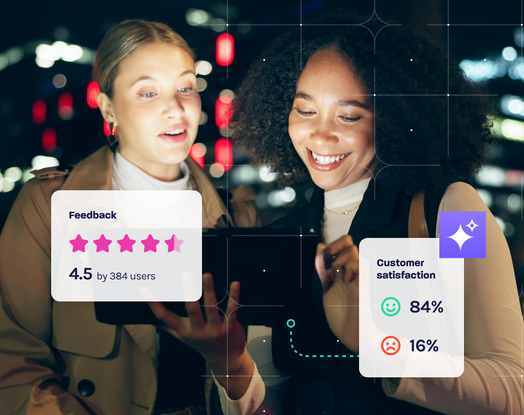
Digital Customer Experience Strategy: Best Practices for 2025 and Beyond
In banking and insurance, customer expectations begin and often end on a screen. Mobile deposits, in-app claims submissions and AI-powered chat support have replaced branch visits and call center queues. This digital-first reality rewards firms that deliver fast, intuitive interactions and penalizes those that don’t.
Leaders have taken notice. More than 80% of executives rank improving customer experience (CX) as a top priority. They understand that seamless digital customer experiences drive customer loyalty, reduce churn and safeguard revenue in markets where switching providers can be as easy as downloading a new app.
This blog will break down the fundamentals, components and best practices of a winning digital experience strategy. You’ll discover how to map the entire customer journey, leverage tagless data capture and AI-driven insights and build an omnichannel ecosystem that keeps customers engaged across every digital touchpoint. Whether you’re refining your current approach or building a program from the ground up, the guidance ahead will help you turn every interaction into an advantage.
What Is a Digital Customer Experience Strategy?
A strong digital customer experience (DCX) strategy orchestrates every interaction a customer has with your brand, from a quick rate check on mobile to post-claim follow-up via live chat. This ensures the journey feels effortless at each digital touchpoint. When executed well, it eliminates friction, accelerates resolution and reinforces trust at moments that matter most.
At its core, a DCX strategy revolves around three commitments:
Meeting rising expectations
Personalizing engagements in real time
Using technology to strengthen customer retention and loyalty
Instead of isolated projects, it functions as an always-on program that continuously refines as data and customer insights are added, maximizing long-term value.
To succeed, your strategy must cover several critical components. Digital-first touchpoints—mobile apps, responsive websites, secure portals, chatbots and email—must work seamlessly together, allowing customers to choose their preferred digital channel. Personalization at scale is essential, with AI-driven analytics surfacing customer preferences, intent and context to tailor offers and customer support flows for each individual.
A frictionless user experience and user interface ensure clean layouts, fast load times, clear navigation and accessible design. This enables users to progress smoothly, whether they’re reviewing policy details or transferring funds. Real-time insights that are powered by tagless data capture, record every click, swipe and tap without manual instrumentation, delivering instant visibility into struggles, drop-offs and performance trends for immediate action.
Together, these components define a strategy agile enough to evolve with shifting customer behaviors and regulatory mandates.
Core Principles of an Effective Digital CX Strategy
Before outlining tactics, it helps to ground your program in a few non-negotiable principles. These core pillars of effective digital customer experience management ensure every customer initiative remains aligned with business goals and keeps pace with evolving customer expectations, providing a framework for sustainable success.
1. Focus on Emotional and Functional Value
Customers judge each interaction on two levels. Functionally, they want tasks, like opening an account or updating coverage, completed quickly and without errors. Emotionally, they seek reassurance that their money and data are safe, their time is respected and their needs are understood. When both dimensions are fulfilled, satisfaction scores rise and loyalty follows. A polished interface without empathy feels cold, while warmth without efficiency leads to frustration. Balancing the two turns transactions into relationships.
2. Make the Experience Seamless and Predictive
Speed alone is no longer enough. Customers expect systems to anticipate intent and remove unnecessary steps. Tagless data capture collects every digital breadcrumb without developers tagging each element, feeding AI models that predict next best actions and flag anomalies in real time. Pair that with journey orchestration, and you can automatically surface the right loan calculator, pre-fill forms or trigger proactive support through live chat before a user even asks—saving effort and boosting conversion.
3. Continuously Learn and Improve from Data
Digital experiences never stand still, so neither can your strategy. Real-time analytics, voice of customer (VoC) surveys and behavioral signals—rage clicks, hesitations, drop-offs—form a feedback loop that guides rapid iterations. AI-driven insights highlight root causes rather than surface-level symptoms, helping teams prioritize fixes that yield the greatest ROI. Embed this “always optimizing” mindset into sprint cycles, A/B tests and roadmap planning so every release meaningfully sharpens the digital customer journey.
With these principles in place, you’re ready to weave them across every touchpoint to create a truly seamless omnichannel experience.
Building a Seamless Omnichannel Experience
Omnichannel success means every channel—mobile, desktop, voice, ATM, in-app or branch—feels like one continuous conversation. When customers check a mortgage rate on their phone at lunch and finalize the application on a laptop that evening, they expect to pick up exactly where they left off, with no repeated forms or lost context.
Journey continuity is critical. Abrupt handoffs often force customers to restate information, eroding trust. True cohesion combines digital and traditional channels consistently so that users stop noticing the channel altogether and simply experience your brand. Behavioral analytics are integral as they help teams track scroll depth, click patterns and abandonment points to identify friction and resolve it quickly. Consistency in navigation and branding ensures customers never second-guess where they are or what to do next. Cross-device session replay technology is essential as it records complete customer journeys, allowing teams to watch a mobile session and a subsequent desktop session as one thread to diagnose issues in context.
Synchronizing data across systems in real time ensures policy numbers, account balances and support tickets update instantly across portals, call centers and chatbots for truly unified service. Empowering staff with a 360-degree view of customer activity lets agents resolve issues without forcing customers to repeat steps. Hospitality giant Marriott provides an excellent example of how cross-channel personalization strengthens loyalty, representing lessons that financial brands can readily adapt.
Executing these steps delivers the cohesive, user-friendly journey that customers demand.
Leveraging Data: X-Data + O-Data = Actionable CX
Personalization that feels effortless requires more than intuition. It demands fusing experience data and operational data into a single, actionable view. When you combine what customers say with what they do, you uncover rich context that powers relevant, real-time engagement.
X-data represents customer sentiment, survey responses, Net Promoter Score (NPS) feedback, support transcripts and social media comments. These insights reveal emotions, expectations and intent.
O-data captures clicks, scrolls, form entries, transaction amounts, device types and load times. These are behavioral signals identifying exactly how customers interact with each digital touchpoint. On their own, each data type tells only half the story. Together, they answer both “what happened?” and “why did it happen?”
Imagine a user abandoning a credit-card application on the final step. O-data pinpoints the exit, while X-data gathered from a quick post-session survey explains that the interest rate slider was confusing.
These insights can be stitched together through tagless data capture and AI-driven analytics, alerting teams to the issue instantly and suggesting the fix that will have the greatest impact. This dual-lens approach reduces form abandonment, drives proactive support, improves loyalty through hyper-targeted offers and accelerates compliance efforts by documenting every click and sentiment for audit-ready transparency.
Credit.com used this methodology to improve user journeys and lift conversions while cutting support calls. This provides proof that unified data translates directly to bottom-line results. With X-data and O-data working in concert, you’re ready to equip your teams with the technology that turns insights into seamless experiences.
Tech Stack That Powers Digital CX
Great strategies falter without the right tools. The most effective technologies reduce friction, amplify personalization and surface insights before issues escalate. Financial services leaders are prioritizing solutions that deliver immediate value and integrate cleanly with existing ecosystems, including advanced CX analytics that reveal where customer journeys succeed or break down.
Solutions include:
Session replay and tagless data capture: Records every customer interaction without manual tagging, letting teams see exactly where users struggle and why.
AI-driven analytics: Provides predictive modeling, anomaly detection and journey analytics, highlighting churn risks, forecasting intent and recommending the next best actions in real time.
VoC platforms: Collect X-data at scale through surveys, sentiment analysis and social listening tools, feeding continuous improvement loops.
Meanwhile, customer data platforms and personalization engines aggregate behavioral, transactional and demographic data, enabling hyper-relevant offers across channels.
Emerging trends point to tighter convergence within CX stacks. For example, GenAI assistants analyze intent and context to generate personalized responses, guide self-service and summarize interactions for agents, boosting efficiency and satisfaction. Low-code integrations, on the other hand, embed CX insights directly into daily operations for product managers, marketers and compliance officers alike. With the right stack in place, you gain the telemetry and agility needed to refine experiences at scale.
Measuring Success: The Right Metrics for Digital CX
You can’t optimize what you don’t measure. A robust scorecard translates digital interactions into clear, actionable insights, letting teams prove ROI and prioritize improvements.
Metrics such as task completion rate, session drop-off rate, Net Promoter Score (NPS), Customer Satisfaction Score (CSAT) and Customer Effort Score and frustration indicators like rage clicks or repeated taps consistently reveal how well your customer experience strategy performs. Combining quantitative metrics (O-data) with qualitative feedback (X-data) offers a 360-degree view of digital experience health.
Both streams can be unified into real-time dashboards, surfacing anomalies instantly, segmenting data by customer cohort, device or geography and automating alerts when key performance indicators deviate from thresholds. Such tools elevate CX management at scale, ensuring continuous improvement becomes a disciplined practice.
8 Best Practices for an Effective Digital Customer Experience Strategy
Building a successful digital customer experience strategy demands intentional, consistent action across every stage of the customer journey. Each interaction, whether a quick balance check or a complex mortgage application, should reinforce your brand’s value and drive measurable results.
1. Start with Journey Mapping Grounded in Empathy
Journey mapping visualizes the entire digital path, spotlighting friction points that damage loyalty or inflate support costs. By pairing journey maps with empathy maps and personas, you ensure every optimization aligns with genuine customer needs rather than internal assumptions, paving the way for meaningful CX improvements.
2. Create a Seamless Omnichannel Experience
Customers move freely between mobile apps, websites, ATMs, call centers and live chat. A cohesive approach synchronizes data and context so users never have to repeat information. Consistent navigation, branding and next best actions across channels build confidence and boost conversion.
3. Prioritize Mobile, Accessibility and Speed
In a mobile-dominated market, a sluggish or inaccessible interface erodes trust instantly. Embrace mobile-first design, ADA compliance and lightweight code to guarantee quick load times and frictionless interactions for every customer, regardless of device or ability.
4. Use Real-Time Behavioral Analytics to Detect Friction
Traditional analytics surface high-level trends but miss critical micro-moments. Real-time behavioral data—session replays, rage clicks and dead ends—expose hidden gaps. Tagless data capture records these signals automatically, letting teams resolve issues before they trigger churn or complaints.
5. Integrate X-Data and O-Data for Richer Insights
Pair survey feedback, chat transcripts, and NPS (X-data) with page views, form fills and transaction history (O-data) to uncover the “why” behind behavior. This fusion powers smarter interventions, proactive support and hyper-relevant offers that strengthen loyalty.
6. Personalize Based on Intent and Micro-Moments
Leverage contextual cues—location, referral source or recent activity—to deliver timely, relevant content. AI-driven insights transform these signals into dynamic personalization, increasing satisfaction and boosting conversion rates without overwhelming customers.
7. Empower Agents and Employees with CX Tools
Digital strategy isn’t solely customer-facing. Equip agents with full journey visibility, real-time data and context-aware prompts so they can act intelligently and efficiently. Empowered employees resolve issues faster, improving both CSAT and operational efficiency.
8. Continuously Test, Learn and Optimize
Digital CX is never static. Agile teams employ A/B testing, heatmaps, live feedback loops and dashboards to refine experiences week after week. This culture of experimentation keeps your strategy resilient to market shifts, regulatory changes, and evolving customer expectations.
Mastering these best practices positions your organization to deliver a proactive, data-powered and personalized experience.
Take Your Digital CX Strategy Further with Glassbox
A winning digital customer experience strategy is proactive, personalized, omnichannel and driven by data. Glassbox equips your teams with the technology and insight to deliver on each of those pillars, turning everyday interactions into lasting loyalty.
Glassbox’s tagless data capture records every tap, swipe and click across web and mobile properties without slowing releases or burdening developers. AI-driven analytics then transform that raw data into clear, prioritized insights, highlighting where customers struggle, predicting next best actions and quantifying ROI. Built-in collaboration tools let product, compliance and support teams diagnose issues together, accelerating fixes while maintaining the rigorous security standards financial institutions require.
When you’re ready to remove blind spots and make every digital moment count, explore our resources and discover how our digital CX solutions can elevate your strategy from concept to competitive advantage.







